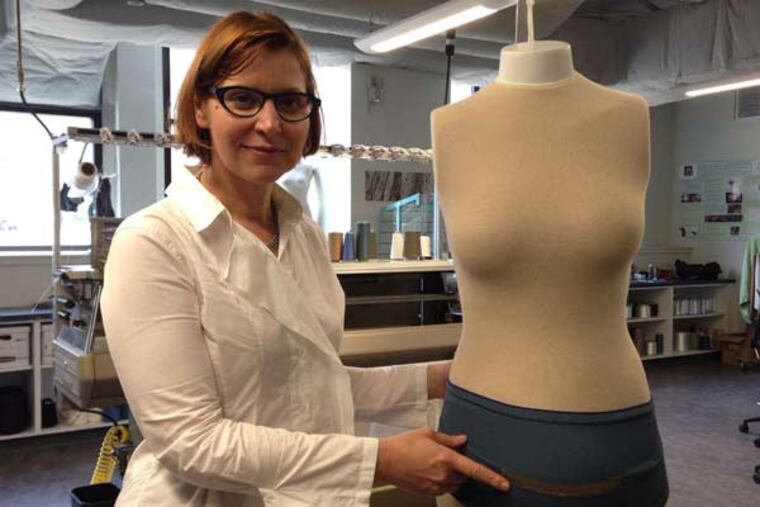At Drexel lab, wearable tech taking shape
Behind a glass wall in Drexel University's ExCITe Center, a fully pregnant mannequin stands tall with nothing on but a strip of knitted blue fabric around its bulging stomach.

Behind a glass wall in Drexel University's ExCITe Center, a fully pregnant mannequin stands tall with nothing on but a strip of knitted blue fabric around its bulging stomach.
The garment, called a belly band, isn't the latest trend in maternity wear; it's an all-knit, wireless fetal monitor.
Drexel's Shima Seiki Haute Technology Laboratory creates smart garments with electronic circuitry knitted right in. So instead of a boxy device on your wrist or around your waist, the clothes themselves become a monitor that is flexible, comfortable, and soft. The lab is working at the intersection of fashion design, engineering, and medicine on what could be the next generation of wearable technology.
Its first venture is the belly band, a stretchy piece of knitted cloth that wraps around an expectant mother's abdomen to measure uterine contractions.
"We're past proof of concept. It works," said belly band engineer Tim Kurzweg, a Drexel associate professor in electrical and computer engineering. "We're in some of the last steps before going into clinical trials."
Traditionally, women will start regular fetal monitoring after about 16 to 20 weeks of pregnancy. Hospital staff strap a belt around the stomach with a pressure-sensitive device called a tocodynamometer that non-invasively records when contractions start and stop.
About the size of a belt buckle and typically made of hard plastic, the device isn't the most comfortable and uses wiring that tethers the patient to the bed. If she wants to get out of bed for any reason, the monitoring must stop.
"Any woman that has worn those [tocodynamometer] straps and sees the belly band - essentially like a tube top piece of fabric - says, 'I want that right now,' " said Owen Montgomery, chair of the department of obstetrics and gynecology at Drexel's College of Medicine.
The lab has tested the belly band on simulation mannequins, and it gave results similar to the tocodynamometer. Belly band engineer Adam Fontecchio, ExCITe's associate director, said the team hopes to conduct FDA qualification testing within the next six months.
The band contains a radio frequency identification (RFID) tag, technology used for tracking pets and vehicles. Electrically conductive thread made of stainless steel or silver is used to knit a pattern across the center of the band. That serves as the antenna, which transmits data to an RFID reader in the room, a cellphone, or bay station of some kind.
"The E-ZPass in your car, that's an example of an RFID," said belly band antenna expert Kapil Dandekar, also a Drexel professor. "The tollbooth sends a signal to the box that's on your windshield that contains information to identify your car."
As the belly band stretches, the frequency of radio waves sent to the RFID reader changes. By analyzing this signal, any tiny stretch in the band due to contractions can be monitored.
"We're making a radio out of fabric. That's not an easy thing," said Dandekar.
Other forthcoming projects include a smart fabric onesie that would sound an alarm if the baby stopped breathing. The team is also thinking about fabric that can automatically contract and expand, such as massaging socks for muscle cramps or a smart hospital garment to help prevent bedsores.
Montgomery serves as the lab's medical expert; three Drexel engineers take care of electronics. At the lab's helm is fashion designer and Shima Seiki director Genevieve Dion.
An industrial designer by training, Dion later moved into high fashion, creating pieces that sold at stores such as Bergdorf Goodman and Barney's for upwards of $10,000.
"When I first came to Drexel seven years ago, I wanted to take my work and philosophy to a broader context," she said. Dion was fascinated by newly emerging ways of creating clothing, in particular using computers to design and control 3D printers and knitting machines.
With wearable technology in mind, she focused her research on these production methods. In 2012, Drexel signed a $1 million agreement with computerized knitting system manufacturer Shima Seiki USA to set up the multidisciplinary research lab in its name. Shima Seiki has donated 16 computer workstations, three computerized knitting machines, and extra funding.
"I hear about wearable tech all the time, but most of the time, they're not garments yet," she said. "It's still almost like science fiction."
One company pushing wearables forward is OMsignal of Montreal. The start-up has created a smart-textile T-shirt that not only records vital signs such as heart rate and breaths per minute, but also interprets the data. So if it detects shallow breathing and a fast-pumping heart, the mobile app reminds the wearer to pause and relax.
"In the end, smart textiles are the natural fit for collecting bio-signal, as we all wear clothes," said Jesse Slade Shantz, OMsignal's chief medical officer.
OMsignal is also interested in health-care applications but realizes the FDA approval process would slow its progress. The belly band team has thought about founding a start-up company, but is seeking a partner to help speed the transition from academic research to the commercial market.
Its current focus is on monitoring uterine contractions, but the goal is to pick up fetal and maternal heart rates, too. The Drexel team continues to perfect the belly band, which has already gone through 20 iterations. The design of the band needs to be tweaked next, such as finding a way to fit women's ever-changing size throughout pregnancy.
Shantz is eager to see what comes out of Shima Seiki and other collaborative centers.
"I think that Drexel is going in the right direction with their cross-disciplinary approach," he said. "Great things emerge from that sort of close collaboration."
857-205-6920